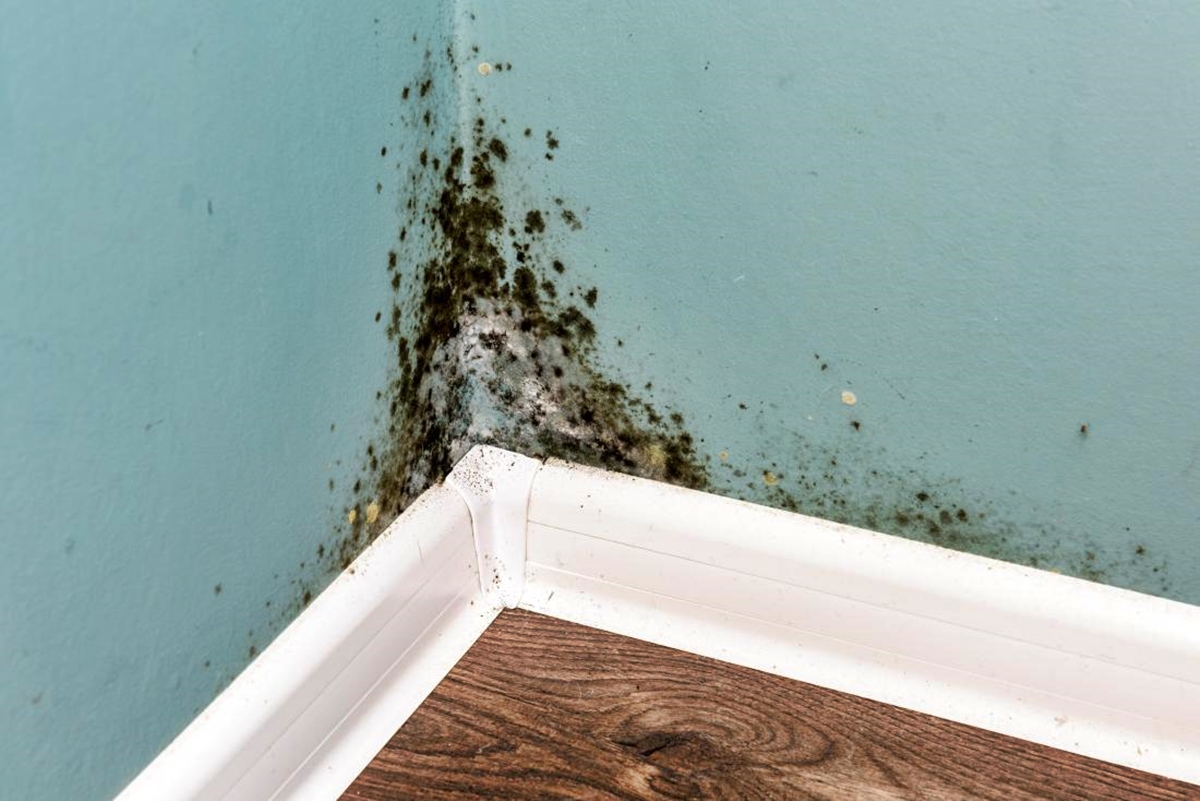

Featured
How Does Mold Affect Your Health
Published: September 5, 2023
Discover how mold can impact your health and find out why it is considered a featured concern that shouldn't be ignored.
Introduction
Welcome to our comprehensive guide on how mold can affect your health. Mold is a common problem that many people encounter in their homes or workplaces. It not only damages the structure of the building but can also have a detrimental impact on your overall health. Understanding the potential health risks associated with mold exposure is crucial for your well-being and that of your loved ones.
But what exactly is mold? How does it grow? And what are the health effects it can have on your body? In this article, we will answer these questions and provide practical tips on how to prevent and deal with mold-related issues.
Mold is a type of fungus that thrives in warm, damp environments. It releases tiny spores into the air, which can be inhaled into your respiratory system. When these spores find a suitable surface to settle on, they can start growing and spreading rapidly. Common areas where mold can be found include basements, bathrooms, kitchens, and areas with water leaks or excess moisture.
When mold starts to grow in your living space, it can lead to a range of health issues. Some people are more susceptible to the effects of mold than others, depending on factors such as their overall health, immune system response, and the duration and intensity of exposure.
In the following sections, we will delve into the various health effects that mold can have on your body. From allergic reactions and respiratory problems to skin irritations and even mold-related infections, we will explore the different ways in which mold can impact your well-being.
We will also discuss who is most at risk of mold-related health issues and provide practical steps you can take to prevent and deal with mold growth in your home or workplace. From detecting and removing mold contamination to seeking professional mold remediation services, we will equip you with the knowledge you need to protect yourself and your loved ones.
Now, let’s explore the world of mold and its impact on our health.
What is Mold?
Mold is a type of fungus that plays a natural role in the environment by decomposing dead organic matter. It is commonly found both indoors and outdoors, and while some molds are harmless, others can pose significant health risks. Mold reproduces by releasing tiny spores into the air, which can be carried to different areas by wind, clothing, or even through ventilation systems. If these spores find a suitable environment with excess moisture, such as a damp wall or ceiling, they can start growing and forming colonies.
Mold comes in various colors and textures, ranging from black, green, and brown to white or yellow. It can appear fuzzy, slimy, or powdery, depending on the type and the surface it is growing on. Some common types of mold that you may encounter include Aspergillus, Cladosporium, Penicillium, and Stachybotrys chartarum, also known as black mold.
While it may seem harmless, mold can be a significant concern when it proliferates indoors. In addition to being unsightly and causing structural damage to buildings, mold can release toxic substances called mycotoxins, which can have adverse effects on human health.
It is important to note that not all individuals react to mold in the same way. Some people may experience mild symptoms, while others may have a more severe reaction. The extent of the health effects also depends on factors such as the amount of mold exposure, individual sensitivity, and pre-existing health conditions.
In the following sections, we will explore the potential health effects of mold exposure in more detail. It is crucial to understand the risks associated with mold in order to take appropriate measures to prevent and address any mold issues in your living or working environment.
Common Types of Mold
Mold comes in various types and forms, each with its own characteristics and potential health risks. Understanding the different types of mold can help you identify and address any mold problems in your home or workplace more effectively. Here are some common types of mold you may encounter:
- Aspergillus: Aspergillus is a genus of mold that can be found both indoors and outdoors. It is widespread and can grow on various surfaces, including walls, food, and household dust. While most species of Aspergillus are harmless to humans, certain types can produce mycotoxins, which can lead to respiratory issues and allergies.
- Cladosporium: Cladosporium is a mold commonly found on living and dead plant material. It can also be found indoors on damp surfaces, such as carpets, wallpapers, and HVAC systems. Exposure to Cladosporium can cause allergic reactions and respiratory problems, particularly in individuals with weakened immune systems.
- Penicillium: Penicillium is a mold that can grow on various organic materials, such as food, paper, and fabrics. It is typically bluish-green in color and has a fuzzy or powdery texture. While some species of Penicillium have beneficial uses, such as in the production of antibiotics, others can produce mycotoxins and cause health issues, including allergic reactions and respiratory problems.
- Stachybotrys Chartarum (Black Mold): Stachybotrys chartarum, commonly known as black mold, is a type of mold that thrives in areas with excessive moisture and cellulose-rich materials, such as drywall and wood. It has a distinct black or dark green appearance and a slimy texture. Black mold is notorious for producing mycotoxins, which can lead to severe health problems, including respiratory issues, skin irritation, and even neurological symptoms.
- Alternaria: Alternaria is a common outdoor mold that can also be found indoors on damp surfaces. It is often found in areas such as bathrooms, kitchens, and basements. Exposure to Alternaria can trigger allergic reactions, such as hay fever and asthma, especially in individuals with a predisposition to allergies.
These are just a few examples of the many types of mold that can be found. It is important to note that mold identification can be challenging, as different molds can have similar appearances. If you suspect you have mold growth in your home, it is recommended to consult with a professional mold inspector or remediation specialist to accurately identify the type of mold and determine the best course of action.
In the next section, we will delve into how mold grows and the environmental conditions that promote its growth.
How Does Mold Grow?
Mold requires specific conditions to grow and thrive. Understanding the factors that contribute to mold growth can help you identify areas in your home or workplace that are prone to mold infestations. Here are the key elements necessary for mold to grow:
- Moisture: Moisture is the primary factor that fuels mold growth. Mold requires a source of water or excess moisture to thrive. This can be in the form of a water leak, high humidity levels, or condensation on surfaces. Areas that are prone to moisture accumulation, such as bathrooms, kitchens, and basements, are common hotspots for mold growth.
- Warmth: Mold tends to flourish in warm environments, with most species growing well between temperatures of 77°F (25°C) and 86°F (30°C). However, there are some molds that can grow in colder temperatures as well. Warmer climates or areas within a building that are consistently warm, like near heating systems or in poorly ventilated spaces, provide an ideal environment for mold growth.
- Organic Material: Mold needs organic matter to feed on. Cellulose-rich materials, such as wood, paper, drywall, and fabrics, provide an abundant food source for mold to grow and thrive. If these materials become damp or moist, they can become a breeding ground for mold colonies.
- Poor Ventilation: Insufficient ventilation can contribute to increased humidity levels and stagnant air, creating an environment conducive to mold growth. Areas with inadequate airflow, like bathrooms without exhaust fans or poorly ventilated attics, can accumulate excess moisture and promote mold infestations.
When these conditions align, mold spores that are present in the air can settle on surfaces and begin to germinate. As the mold spores absorb moisture and nutrients from the organic material, they form a network of thread-like structures called hyphae. These hyphae grow and spread, creating visible patches of mold on surfaces.
It is crucial to address any moisture issues promptly to prevent mold growth. Regularly inspecting your home for water leaks, maintaining proper ventilation, and ensuring that areas prone to dampness, such as bathrooms and basements, are kept dry can help minimize the risk of mold infestations.
In the next section, we will discuss the potential health effects of mold exposure and how it can impact your well-being.
Health Effects of Mold Exposure
Mold exposure can have a range of health effects on individuals, varying from mild allergic reactions to more severe respiratory conditions. The health risks depend on several factors, including the type of mold, the duration of exposure, and individual susceptibility. Here are some common health effects associated with mold exposure:
- Allergic Reactions: Many people are sensitive to mold allergens and may experience allergic reactions when exposed to mold spores. Symptoms can include sneezing, runny or stuffy nose, itchy and watery eyes, coughing, and skin rash or hives. For individuals with allergies or asthma, mold exposure can exacerbate their symptoms and lead to more frequent and severe attacks.
- Respiratory Issues: Prolonged exposure to mold can lead to respiratory problems, especially in individuals with weaker immune systems or pre-existing respiratory conditions. Common respiratory issues associated with mold exposure include coughing, wheezing, shortness of breath, chest tightness, and throat irritation. In some cases, mold exposure can contribute to the development of chronic respiratory conditions, such as bronchitis or chronic obstructive pulmonary disease (COPD).
- Skin Irritations: Direct contact with mold or mold-infested materials can cause skin irritations. This can result in redness, itchiness, and rashes. Individuals with sensitive skin may be more prone to experiencing these skin reactions when in contact with mold.
- Asthma: Mold exposure has been linked to the development of asthma in some individuals. Asthma is a chronic respiratory condition characterized by inflammation and narrowing of the airways, leading to wheezing, coughing, and difficulty breathing. Mold spores can trigger asthma symptoms and contribute to asthma attacks, making it crucial for individuals with asthma to avoid exposure to mold.
- Mold-Related Infections: In rare cases, certain types of mold can cause infections in individuals with weakened immune systems. These infections can be localized, affecting the skin, or more systemic, affecting internal organs. Common mold-related infections include aspergillosis and mucormycosis. Prompt medical attention is necessary to diagnose and treat these infections effectively.
It is important to mention that the severity of these health effects can vary and depend on individual sensitivity and the extent of mold exposure. Some individuals may experience mild symptoms that subside when they are no longer exposed to mold, while others may develop more persistent and severe health issues. If you suspect that mold is affecting your health, it is advisable to consult with a healthcare professional for an accurate diagnosis and appropriate treatment.
In the next sections, we will discuss who is at higher risk of mold-related health issues and practical measures you can take to prevent and address mold growth.
Allergic Reactions
Allergic reactions are one of the most common health effects associated with mold exposure. When mold spores are inhaled or come into contact with sensitive individuals, the immune system reacts by releasing histamines and other chemicals, leading to allergy symptoms. These symptoms can vary in severity, ranging from mild discomfort to more significant reactions. Here are some key points about allergic reactions to mold:
- Respiratory Symptoms: One of the primary ways mold allergies manifest is through respiratory symptoms. These may include sneezing, coughing, a runny or stuffy nose, and throat irritation. People with mold allergies may experience these symptoms when they are in close proximity to mold-infested areas or when they come into contact with mold-contaminated objects.
- Eye and Skin Reactions: Mold allergies can also affect the eyes and skin. Itchy, watery, and red eyes are common allergic reactions to mold exposure. Additionally, some individuals may experience skin reactions, such as itching, redness, or hives, upon contact with mold or mold-infested materials.
- Allergic Asthma: Mold allergies can trigger or worsen asthma symptoms in individuals with asthma. Wheezing, difficulty breathing, chest tightness, and coughing may occur as a result of mold exposure. It is essential for individuals with asthma to be vigilant about preventing mold growth and minimizing exposure to mold spores to manage their condition effectively.
- Sensitivity and Duration of Exposure: The severity of allergic reactions to mold can vary depending on individual sensitivity and the duration of exposure. Some individuals may experience only mild symptoms that subside quickly once they are no longer near mold, while others may have more severe and persistent reactions.
- Cross-Reactivity: Some individuals who are allergic to certain types of pollen may also experience cross-reactivity with mold spores. This means that their immune system may mistake mold spores for pollen, leading to similar allergic reactions. It is worth noting that not everyone with pollen allergies will necessarily have mold allergies, and vice versa.
If you suspect that you have mold allergies, it is advisable to consult with an allergist or immunologist. They can perform allergy tests to identify specific mold allergens that may be triggering your symptoms. Once identified, you can take appropriate measures to reduce your exposure to mold and manage your allergic reactions effectively.
In the following sections, we will explore additional health effects of mold exposure and provide practical tips for preventing and addressing mold growth.
Respiratory Issues
One of the significant health effects of mold exposure is respiratory issues. When mold spores are inhaled, they can irritate the respiratory system, leading to a range of respiratory symptoms and potentially exacerbating existing respiratory conditions. Here are some important points to understand about respiratory issues caused by mold:
- Coughing and Wheezing: Mold exposure can trigger coughing and wheezing in susceptible individuals. The presence of mold spores in the air can irritate the airways, leading to an increase in mucus production and inflammation, causing coughing and wheezing sounds while breathing.
- Shortness of Breath: Some individuals may experience shortness of breath or difficulty breathing after exposure to mold. This can be particularly problematic for individuals with asthma or other underlying respiratory conditions.
- Chest Tightness: The inhalation of mold spores can cause a sensation of tightness or discomfort in the chest area. This can be accompanied by difficulty taking deep breaths or a feeling of restricted airflow.
- Asthma Exacerbation: Mold exposure can worsen asthma symptoms in individuals with asthma. It can act as a trigger, leading to asthma attacks characterized by coughing, wheezing, shortness of breath, and chest tightness. Individuals with asthma should be especially cautious about mold exposure and take steps to minimize it to manage their condition effectively.
- Increased Risk of Respiratory Infections: Prolonged exposure to mold spores can weaken the respiratory system and make individuals more susceptible to respiratory infections like bronchitis and pneumonia. This is particularly true for those with weakened immune systems, such as infants, the elderly, and individuals with compromised immune systems.
If you experience persistent or severe respiratory symptoms after exposure to mold, it is important to seek medical attention. A healthcare professional can evaluate your symptoms, conduct necessary tests, and provide appropriate treatment to alleviate respiratory issues caused by mold exposure.
Preventing mold growth and minimizing exposure to mold spores is crucial for individuals experiencing respiratory issues. In the following sections, we will share practical tips on how to prevent and address mold growth in your home or workplace.
Skin Irritations
Skin irritations are another common health effect that can occur as a result of mold exposure. When mold comes into direct contact with the skin, it can cause various skin reactions and discomfort. Here are some important points to understand about skin irritations caused by mold:
- Redness and Itching: Direct contact with mold or mold-infested materials can lead to redness and itching of the skin. This can occur if you touch mold growth or come into contact with objects or surfaces contaminated with mold.
- Rashes: Some individuals may develop rashes on their skin after exposure to mold. The rashes can range from small, itchy bumps to larger, inflamed patches. The severity and appearance of the rash can vary depending on individual sensitivity and the type of mold encountered.
- Hives: In some cases, mold exposure can trigger an allergic reaction in the form of hives. Hives are raised, itchy welts that can appear anywhere on the body. They can vary in size and shape and may come and go over a period of time.
- Sensitivity: Certain individuals may be more susceptible to experiencing skin irritations from mold exposure. People with sensitive skin or a history of skin allergies may be particularly prone to developing skin reactions when in contact with mold.
- Secondary Infections: Continuous scratching of the itchy skin caused by mold exposure can lead to breaks in the skin, making it more susceptible to secondary infections. This can result in bacterial or fungal infections, which may require medical attention to treat effectively.
If you experience persistent or severe skin irritations after exposure to mold, it is important to seek medical advice. A healthcare professional can assess your symptoms and provide appropriate treatment or recommend measures to alleviate discomfort and promote skin healing.
Preventing direct skin contact with mold is crucial to avoid skin irritations. When dealing with mold-infested areas or objects, it is recommended to wear gloves and protective clothing to minimize direct exposure. Additionally, practicing good hygiene by washing your hands thoroughly after handling mold or mold-contaminated materials can help reduce the risk of skin irritations.
In the following sections, we will explore practical tips for preventing and addressing mold growth to minimize the risk of health issues, including skin irritations.
Asthma
Asthma is a chronic respiratory condition characterized by inflammation and narrowing of the airways. Mold exposure can trigger or worsen asthma symptoms in individuals with asthma, leading to respiratory distress and reduced lung function. Here are some important points to understand about asthma and its relationship to mold exposure:
- Asthma Symptoms: Asthma symptoms can vary in severity and presentation, but common signs include coughing, wheezing, shortness of breath, and chest tightness. These symptoms occur due to the constriction and inflammation of the airways, making it more difficult to breathe.
- Triggers and Mold: Mold spores are a known trigger for asthma symptoms. When individuals with asthma inhale mold spores, their airways can become inflamed, leading to the characteristic symptoms of an asthma attack. The severity of the symptoms can vary depending on the individual’s sensitivity to mold and the amount of exposure.
- Pre-existing Asthma and Sensitivity to Mold: Individuals with pre-existing asthma may be more susceptible to mold-related asthma attacks. Their airways may be hypersensitive to various triggers, including mold spores. These individuals may experience more frequent and severe symptoms when exposed to mold, making it crucial for them to take steps to minimize their exposure.
- Managing Asthma and Mold: If you have asthma, it is essential to manage your condition while minimizing exposure to mold. This includes regular health monitoring, adhering to prescribed medications, and implementing strategies to reduce mold growth in your living environment. Taking these measures can help prevent asthma attacks triggered by mold exposure.
- Professional Advice: It is recommended that individuals with asthma consult with their healthcare provider for guidance on managing their asthma and reducing exposure to mold. Your physician may provide personalized advice and treatment options based on your specific condition and triggers.
Taking proactive measures to prevent and address mold growth is crucial for individuals with asthma. This includes keeping indoor spaces clean and dry, addressing any water leaks or moisture issues promptly, using air purifiers or filters to remove mold spores from the air, and regularly cleaning and maintaining heating, ventilation, and air conditioning (HVAC) systems.
By effectively managing asthma and minimizing exposure to mold, individuals can better control their symptoms and improve their overall respiratory health.
In the following sections, we will explore practical tips for preventing and addressing mold growth to reduce the risk of asthma symptoms triggered by mold exposure.
Mold-Related Infections
In rare cases, certain types of mold can cause infections, especially in individuals with weakened immune systems. These mold-related infections can result from direct exposure to mold spores or through the inhalation of mold-contaminated air. Here are some important points to understand about mold-related infections:
- Opportunistic Infections: Mold-related infections are often classified as opportunistic infections, meaning they typically affect individuals with compromised immune systems, such as those with HIV/AIDS, undergoing chemotherapy, or receiving organ transplants. These individuals are more susceptible to fungal infections, including those caused by mold.
- Inhalation Infections: Certain molds, such as Aspergillus species, can cause respiratory infections when inhaled. Inhalation of mold spores can lead to conditions such as aspergillosis, which can affect the lungs and cause symptoms such as coughing, shortness of breath, and chest pain.
- Cutaneous Infections: Mold can also cause infections of the skin when it comes into direct contact with open wounds or compromised skin barriers. These infections can range from mild irritations to more severe conditions, such as cellulitis or invasive skin infections.
- Systemic Infections: In some cases, mold-related infections can become systemic, spreading throughout the body and affecting multiple organs. Examples of systemic fungal infections include invasive aspergillosis and mucormycosis. These infections can be life-threatening, particularly for individuals with weakened immune systems.
- Timely Diagnosis and Treatment: It is essential to seek medical attention if you suspect a mold-related infection, especially if you have a weakened immune system or are experiencing persistent symptoms. Prompt diagnosis and appropriate treatment are necessary to manage these infections effectively.
It is important to note that mold-related infections are relatively rare, and most healthy individuals are not at significant risk. However, individuals with weakened immune systems should take extra precautions to avoid exposure to mold spores and seek medical advice if they develop symptoms that could indicate a fungal infection.
Preventing mold growth and minimizing exposure to mold is crucial, especially for individuals at higher risk of mold-related infections. Regularly cleaning and maintaining living environments, practicing good hygiene, and seeking professional mold remediation services when necessary can help reduce the risk of mold-related infections.
In the following sections, we will explore practical tips for preventing and addressing mold growth to maintain a healthy living or working environment.
Who is at Risk?
While mold can affect anyone, certain individuals may be more susceptible to the health risks associated with mold exposure. Here are some factors that can contribute to an increased risk:
- Individuals with Allergies: Individuals who already have existing allergies, such as hay fever or allergic rhinitis, are more likely to experience allergic reactions to mold. Their immune systems may be hypersensitive to mold spores, resulting in more severe symptoms.
- Asthmatics: People with asthma are at higher risk of experiencing asthma attacks triggered by mold exposure. Mold spores can irritate the airways and contribute to inflammation, leading to coughing, wheezing, and shortness of breath. Managing asthma and minimizing exposure to mold are essential for individuals with this condition.
- Immunocompromised Individuals: Individuals with weakened immune systems, such as those with HIV/AIDS, undergoing chemotherapy, or taking immunosuppressive medications, are more vulnerable to mold-related health issues. They may be more susceptible to mold infections and experience more severe symptoms.
- Infants and Children: Young children, especially infants, have developing immune systems and may be more sensitive to mold. They may also spend more time indoors, increasing their exposure to mold spores if there is mold growth in their environment.
- The Elderly: Older adults may have weakened immune systems and may be more prone to respiratory problems. Additionally, they may spend more time indoors, making them more susceptible to mold exposure if there is mold growth in their living environment.
- Occupational Exposure: Certain occupations, such as construction, agriculture, and healthcare, can involve increased exposure to mold. Workers in these fields may have a higher risk of mold-related health issues due to their frequent and prolonged exposure to mold spores.
- Frequent Travelers: Individuals who travel frequently may be exposed to various environments and different levels of mold. Staying in mold-contaminated accommodations or visiting locations with high humidity or mold issues can increase the risk of mold-related health problems.
- Individual Sensitivity: Lastly, individual sensitivity plays a role in determining the risk of mold-related health issues. Some people may be more sensitive to mold spores, experiencing stronger reactions even in lower concentrations, while others may have a milder response.
It is important for individuals at higher risk to be aware of the potential health risks associated with mold exposure. Taking proactive measures to prevent and address mold growth, such as maintaining proper ventilation, controlling moisture levels, and seeking professional mold remediation when needed, can help reduce the risk of health issues.
In the next sections, we will delve into practical methods to prevent and address mold growth in your living or working environment.
Prevention Methods
Preventing mold growth is key to reducing the risk of health issues associated with mold exposure. By implementing effective prevention methods, you can create a healthier living or working environment. Here are some practical tips to help prevent mold growth:
- Maintain Proper Ventilation: Ensure adequate ventilation in your home or workplace. Use exhaust fans in bathrooms and kitchens to reduce humidity levels and promote air circulation. Open windows when weather permits to allow fresh air to flow through the space.
- Control Moisture Levels: Prevent excess moisture by promptly addressing water leaks, plumbing issues, or any sources of water intrusion. Repair leaks and dry any damp areas within 24-48 hours to prevent mold growth. Use dehumidifiers in areas with high humidity, such as basements, to maintain optimal moisture levels.
- Proper Insulation: Properly insulate your home to prevent condensation on walls and ceilings. Insulation helps regulate temperature and minimize moisture buildup, reducing the conditions favorable for mold growth.
- Monitor Indoor Humidity: Maintain indoor humidity levels between 30% and 50% to discourage mold growth. Use hygrometers to measure humidity and take appropriate action if levels exceed the recommended range. Consider using air conditioners or humidifiers to control humidity levels as needed.
- Address Water Damage Immediately: If you experience water damage due to flooding, leaks, or spills, take immediate action to dry and clean the affected areas thoroughly. Remove any wet materials, such as carpets or furniture, and dry them completely. Using fans and dehumidifiers can help expedite the drying process.
- Regularly Clean and Maintain: Regularly clean and maintain your home or workplace to prevent mold growth. Clean bathrooms and kitchens regularly using mold-inhibiting cleaners. Regularly vacuum and dust to remove any potential mold spores that may have settled on surfaces.
- Properly Store Items: Store items in plastic bins or sealed containers, especially in areas susceptible to moisture, such as basements or attics. This helps protect your belongings from mold and prevents mold growth on porous surfaces.
- Monitor and Repair Roofing and Gutters: Regularly inspect and maintain your roofing and gutters to prevent water penetration. Address any leaks or deteriorations promptly to prevent water damage and subsequent mold growth.
By following these prevention methods, you can significantly reduce the risk of mold growth and create a healthier living or working environment for yourself and others.
In the next sections, we will discuss how to detect and remove mold, as well as when it’s necessary to seek professional mold remediation services.
Detecting and Removing Mold
Detecting mold early is essential to prevent its spread and mitigate potential health risks. Here are some steps to help detect and remove mold from your living or working environment:
- Visual Inspection: Regularly conduct visual inspections of your home or workplace to identify any signs of mold growth. Look for visible mold growth on walls, ceilings, floors, and other surfaces. Pay attention to areas that are prone to moisture, such as bathrooms, kitchens, basements, and areas with known water leaks or damage.
- Musty Odor: Mold often produces a distinct musty odor. If you notice a musty smell in certain areas, it may indicate the presence of hidden mold. Investigate further to locate the source of the odor and potential mold growth.
- Leaks and Water Intrusion: Keep an eye out for any signs of water leaks or water intrusion, as these are prime conditions for mold growth. Stains, discoloration, or moisture on walls, ceilings, or floors can indicate a water issue that may be promoting mold growth.
- Mold Testing: In some cases, it may be necessary to conduct mold testing to identify the type and concentration of mold in your environment. Mold testing can be done by professionals who collect air or surface samples for laboratory analysis. This can help determine the extent of mold contamination and guide the appropriate remediation measures.
- DIY Remediation: If you detect mold growth in your home or workplace, you may attempt to remove it yourself if the affected area is small (less than 10 square feet) and you have the necessary knowledge and precautions. Use protective equipment such as gloves, goggles, and a mask to avoid direct contact with mold spores. Clean the affected area with a mixture of mild detergent and water, scrubbing away visible mold. Thoroughly dry the area afterward to prevent regrowth.
- Professional Remediation: For larger mold infestations or situations where the mold has spread to multiple areas, it is advisable to seek professional mold remediation services. Certified mold remediation specialists have the expertise and equipment to safely and effectively remove mold and prevent its reoccurrence. They follow proper containment procedures and use specialized techniques to ensure thorough remediation.
- Preventive Measures: After removing mold, take preventive measures to minimize the chances of mold regrowth. Address any underlying moisture issues, repair leaks, improve ventilation, and maintain proper humidity levels. Regularly clean and inspect your living or working environment to catch any potential mold growth early.
Early detection and proper removal of mold are crucial for maintaining a healthy indoor environment. If you are unsure about the extent or type of mold growth, it is recommended to consult with a professional mold inspector or remediation specialist to ensure thorough detection and safe removal.
In the next section, we will discuss the importance of professional mold remediation in certain situations.
Cleaning up Mold Contamination
When dealing with mold contamination, it is essential to clean it up properly to ensure the removal of mold spores and prevent further growth. Here are some steps to follow when cleaning up mold contamination:
- Protection: Prioritize your safety by wearing the appropriate protective gear. This includes gloves, goggles, and a mask or respirator to avoid direct contact with mold spores and minimize inhalation of mold particles.
- Containment: Before starting the cleaning process, isolate the affected area to prevent the spread of mold spores to other parts of the building. Close doors, seal off vents, and use plastic sheeting to cover doorways and openings. This containment will help minimize the risk of cross-contamination.
- Dampen the Area: Lightly mist the mold-infested area with water to minimize the release of mold spores into the air during cleaning. This helps to prevent the spores from becoming airborne and spreading to other areas.
- Remove Contaminated Materials: If there are materials such as carpets, drywall, or insulation that are extensively contaminated by mold, it may be necessary to remove and discard them. Double-bag the materials in heavy-duty plastic bags and dispose of them following local guidelines for mold-contaminated waste.
- Clean with Mold-Inhibiting Solutions: Clean the surfaces with a mold-inhibiting solution or a mixture of detergent and water. Scrub the affected areas thoroughly to remove visible mold. Avoid using bleach as a primary cleaning agent, as it may not effectively kill all mold spores and can create fumes. Follow the manufacturer’s instructions for the cleaning solution or consult with a professional for guidance.
- Dry the Area: After cleaning, ensure the area is thoroughly dried. Use fans and dehumidifiers to promote adequate airflow and reduce moisture. Be diligent in monitoring the area for any signs of moisture accumulation or mold regrowth.
- Inspect for Hidden Mold: Conduct a thorough inspection to check for any hidden mold growth. Pay attention to areas that are prone to moisture, such as behind walls, under carpets, and inside air ducts. If necessary, consider using mold testing methods or consulting with professionals to identify hidden mold and ensure it is properly addressed.
- Preventive Measures: Take preventive measures to reduce the likelihood of future mold growth. This includes addressing any underlying moisture issues, improving ventilation, using mold-resistant building materials, and properly maintaining your living or working environment.
It is important to note that while DIY mold cleaning may be suitable for small, localized areas of mold contamination, larger infestations or situations with extensive mold growth require professional mold remediation. Professional remediation ensures thorough and safe removal of mold and reduces the risk of recurring issues.
In the next section, we will discuss the importance of seeking professional mold remediation services in certain situations.
Professional Mold Remediation
In certain situations, professional mold remediation services may be necessary to effectively and safely address mold contamination. Licensed mold remediation professionals have the expertise, experience, and equipment to handle larger or more complex mold issues. Here are some reasons why professional mold remediation may be essential:
- Extensive Mold Growth: If the mold contamination covers a large area (more than 10 square feet) or if it has spread to multiple areas of the building, professional remediation is necessary. Certified professionals can assess the extent of the mold growth, create a remediation plan, and ensure thorough removal of the mold. They also have the equipment to contain and properly dispose of the mold-contaminated materials.
- Hidden Mold: Professional mold remediation is recommended when dealing with hidden mold that is not easily visible or accessible. Mold can grow behind walls, under floorboards, or inside air ducts, making it challenging to detect and effectively address without specialized equipment and techniques. Professionals can conduct thorough inspections, use advanced testing methods, and employ specialized remediation methods to address hidden mold issues.
- Health Concerns: If you or others in the building are experiencing severe allergic reactions, asthma attacks, or other health issues related to mold exposure, it is crucial to seek professional help. Mold remediation experts can identify the underlying cause of the health problems, properly remove the mold, and implement preventive measures to ensure a healthier indoor environment.
- Preventing Cross-Contamination: Professionals are trained to take necessary precautions to prevent cross-contamination during the remediation process. They use containment procedures such as negative air pressure, physical barriers, and air filtration systems to control the spread of mold spores to unaffected areas of the building.
- Expertise and Experience: Professional mold remediation companies have the knowledge, experience, and specialized training to handle mold issues effectively. They stay updated with the latest industry standards and best practices, ensuring that mold remediation is done correctly and in compliance with regulations.
- Documentation and Insurance: Hiring professionals to conduct mold remediation provides you with documentation of the work performed. This documentation can be valuable for insurance claims or if you plan to sell or rent the property in the future. Additionally, reputable mold remediation companies carry appropriate insurance coverage to protect you, the property owner, and themselves during the remediation process.
When selecting a professional mold remediation company, ensure they are certified and have a good reputation. Research their qualifications, read reviews, and ask for references if needed. It is important to choose a company that has the expertise and reliability to handle your specific mold remediation needs.
In the next section, we will conclude with a summary of the importance of preventing and addressing mold growth for your health and well-being.
Conclusion
Mold can have significant implications for both your health and the integrity of your living or working environment. Understanding the risks and taking proactive measures to prevent and address mold growth is crucial for creating a safe and healthy indoor space. We have explored various aspects of mold, including its types, growth conditions, and health effects.
Mold can cause allergic reactions, respiratory issues, skin irritations, asthma exacerbations, and even mold-related infections, especially in individuals with weakened immune systems. Those with allergies, asthma, or compromised immune systems are particularly vulnerable to the health risks associated with mold exposure. Infants, children, the elderly, and frequent travelers are also at higher risk.
To prevent mold growth, it is important to maintain proper ventilation, control moisture levels, inspect for leaks, and address water damage promptly. Regular cleaning, especially in areas prone to dampness, is essential. If mold is detected, it is crucial to remove it properly, taking necessary precautions to protect yourself from direct contact with mold spores during the cleaning process.
In some cases, professional mold remediation services may be necessary, especially for extensive mold growth, hidden mold, or health concerns. Certified professionals can safely remove mold, prevent cross-contamination, and provide the expertise needed for thorough remediation.
By adopting these preventive measures and addressing mold contamination promptly and effectively, you can create a healthy indoor environment, reduce the risk of health issues, and preserve the structural integrity of your living or working space.
Remember, prevention is key. Regular inspections, prompt moisture control, and maintaining good indoor hygiene are essential in keeping mold at bay. If you suspect mold growth or experience health issues related to mold exposure, consult with professionals and healthcare providers for proper assessment and assistance.







